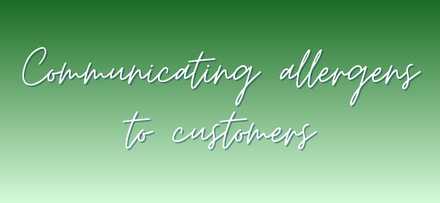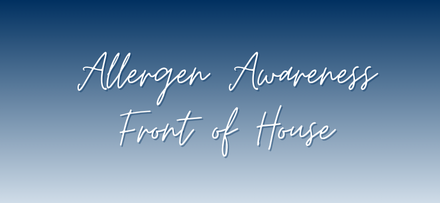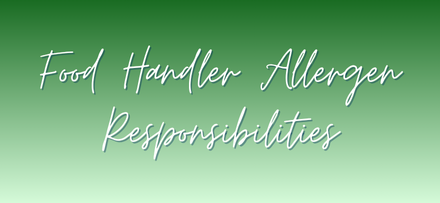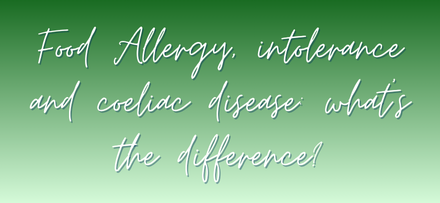
How to prevent allergen cross-contact in your kitchen
Table of Contents
It’s extremely important for any food business to prevent allergen cross-contact or allergen cross-contamination, as it’s also known.
You might have the best allergen folder and procedures in the in the world, but if your kitchen practices aren’t up to scratch, you could still be putting customers at risk.
Even trace amounts of an allergen can cause a serious reaction. That’s why it’s essential to prevent allergen cross-contact.
Let’s break this down.
Prevent allergen cross-contact: allergens are like glitter
Allergen cross-contact happens when traces of an allergen accidently make their way into a product or dish that wasn’t meant to contain them.
Here’s a simple way to explain it to your team. Allergens are like glitter. If you open a pot of glitter in one corner of the kitchen, you’ll still find it on someone’s sleeve or in a salad bowl five metres away.
Allergens behave the same way. If you’re not careful, tiny particles can spread through hands, surfaces, equipment, and even the air. And unlike glitter, you can’t see them. This is why for a food business, it’s critical to prevent allergen cross-contact.

How does allergen cross-contact or cross-contamination happen?
Allergen cross-contact can happen in lots of ways. Here are the five most common:
1. Food-to-food contact
This might happen when different foods are stored too closely and end up touching or when one food spills or drips onto another.
For example:
- Fish and shellfish stored in the same container.
- Bread crumbs falling onto a salad
- Storing allergenic and non-allergenic foods together in the same container

2. Surface and equipment contact
Allergens can easily transfer from:
- Knives and chopping boards
- Worktops, trays or serving spoons
- Unclean blenders or mixers
- Shared grills, woks or fryers
Here’s some examples:
- A whisk that is used to make a sauce containing milk and then used again for a dairy-free or milk-free version, without being properly cleaned in between.
- Chopping fish and shellfish on the same board without thoroughly cleaning the board in between.
- Using the same wok for different stir fries. Such as one that contains soy sauce and another that doesn’t.
If a surface or piece of equipment has touched an allergen and isn’t properly cleaned, it can transfer that allergen to the next dish.
3. Hand contact
Hands are like delivery vans. Whatever you touch gets delivered to the next ingredient, surface or customer plate. Cross-contact can happen if someone:
- Handles different foods and ingredients without washing their hands
- Wears gloves and forgets to change them between tasks or handles multiple ingredients containing allergens
- Clears plates and then serves food without hand washing
4. Airborne particles
This is especially important for powders like flour, milk powder, or spices. Even if you don’t see it, it’s there. These can become airborne during sifting, pouring, or whisking and settle on surfaces, equipment, or food prepared nearby.
5. Shared cooking liquids
For example; using the same fryer to cook battered chicken and chips that are suppose to be gluten-free. Another example is boiling egg pasta or noodles in the same water that’s later used for egg-free pasta or noodles. That shared liquid can become a vehicle for allergens.
Practical steps to prevent allergen cross-contact
Let’s walk through each stage of a typical catering operation and look at practical controls you can apply to prevent allergen cross-contact. While many of these apply to the kitchen, it’s just as important for front of house teams to understand them too, especially when handling allergen requests from customers.
1. Purchasing ingredients
- Choose reputable suppliers who understand allergen risks and commit to notifying you about substitutions or ingredient changes.
- Make sure products and ingredients are clearly and accurately labelled.
- Have a robust recall procedure in place so affected products can be quickly identified, removed from use and disposed of or returned to the supplier.
2. Deliveries
- Cross-check each delivery against your original order.
- Watch out for unannounced substitutions and changes in ingredients.
- Review all supplier paperwork and labels for any updates or changes.
- Reject products with damaged, unclear or non-English labels or compromised packaging.
- Store labels or product specs in a shared folder or hard copy allergen file.
- Record any changes in ingredients or product substitutions and communicate these across the business immediately.
3. Food storage
- Store all ingredients in sealed, clearly labelled containers or packaging. Wherever possible, keep items in their original packaging.
- To minimise the risk of cross-contamination, avoid decanting flour as this can lead to spills around containers. Instead, it’s recommended to place the original flour bag directly into storage containers.
- If decanting food items or ingredients, label thoroughly with full ingredients and accurate allergen information. For example; using the label from the original packaging or another accurate label.
- Don’t top up containers with different brands of a product unless the new product is confirmed to be identical in ingredient and allergen content.
- Store allergenic ingredients separately from non-allergenic ones or on lower shelves.
- Clean up spills immediately following a clear procedure.
- Don’t use damaged or compromised packaging for allergen-free prep.
- Only reuse containers if thoroughly cleaned and relabelled. Ideally, use dedicated allergen-free containers. Also, remove all old labels to avoid confusion or misidentification and apply clear accurate labelling on the container or inside it, identifying the current contents and allergens.
4. Preparation and cooking
- Clean all utensils, surfaces and equipment thoroughly before each use. Especially after they’ve been used to prepare allergenic foods.
- Wash hands between tasks. Especially when switching between allergenic and allergen-free prep.
- Use separate equipment, utensils, and prep areas for allergenic and allergen-free foods, whenever possible. If that’s not possible, clean everything thoroughly after preparing allergenic ingredients and before preparing food for a customer with a food allergy. Stick to standard recipes. If anything changes, update allergen info and inform the team.
- Keep surfaces clean by regularly removing visible food debris and crumbs.
- Use dedicated equipment (i.e. fryer or toaster) for allergenic and non-allergenic products. If this is not possible, make sure the customer is informed.
- Position allergen-free dishes above those with allergens in the oven. Or wrap in foil or greaseproof paper.
- Use separate fryers or oil for allergen-free food. That means gluten-free foods must not be cooked in the same oil as battered foods.
- Do not attempt to fix mistakes when preparing an allergen-free dish. Start the dish again with fresh ingredients and clean equipment.
- Double check garnishes, sauces and toppings for allergens. Leave them off if needed.
- Remember: cooking does not destroy allergens.
- Make sure there is a clear process in place so the allergen-free meal reaches the right customer.
- Always inform the customer if you can’t guarantee their meal will be free from cross-contamination so that they can make an informed decision.
- If a plate gets contaminated i.e. by a spill, never wipe it off and serve it, start fresh.
5. Service, display and buffets
Service:
- Always ask at key points if guests have food allergies, intolerances or coeliac disease — when booking, on arrival and at the point of ordering.
- Wash hands thoroughly before handling any plates, cutlery or food intended for customers with allergies.
- Use a system to clearly identify allergen-free meals and deliver them to the right customer.
- Deliver allergen-free dishes separately to avoid contact with other plates.
- Avoid using wooden boards, slates or baskets as they’re hard to clean and can retain allergens.
Buffets:
- Use separate, clearly distinguishable utensils for each dish.
- Display foods containing allergens separately. Alternatively, have a separately plated meal that has been tailored to the requirements of the Food Hypersensitive customer.
- Display allergen information next to each item or signage directly customers to ask for allergen information.
- Regularly monitor buffets to prevent mix-ups or utensil sharing.
6. Transportation and delivery
- All items must be fully covered or packaged and clearly labelled.
- Separate allergen-free items physically where possible. If not, place them at the top of the stack.
- Train delivery and packing staff on how to prevent cross-contact.
7. Bars and drinks
- Ask about allergies when taking drink orders.
- Keep garnishes and potential allergens (like nuts) in sealed containers.
- Clearly label drink ingredients and provide allergen info on request.
- Be aware of allergens in unexpected ingredients like egg whites in cocktails, sulphites in wine and Worcestershire sauce (contains fish) in Bloody Marys.
- Consider cross-contact risks from shared equipment such as cocktail shakers.
- Train bar staff to recognise hidden allergen risks, cross-contact risks and make sure they understand how to respond to allergen requests from customers.
Cleaning and hand washing to prevent allergen cross-contact
Proper cleaning and hand hygiene are essential in controlling allergens and to prevent allergen cross-contact.
Cleaning:
- Use the two-stage cleaning process: first clean with detergent to remove allergens, then use the appropriate disinfectant or sanitiser in accordance with the manufacturer’s instructions.
- Understand that disinfectants and sanitisers alone don’t ‘deactivate’ allergens, physical cleaning to remove the allergens is critical.
- Dismantle equipment when needed to clean hidden spaces where flour dust or seeds may get trapped. Where possible, use a dishwasher to help ensure removal of allergens.
- Use single-use cloths wherever possible to avoid spreading allergens.
- Clean up spills immediately
- Use colour-coded cleaning equipment for allergen-free prep areas, where possible.

Hand washing:
- Wash hands regularly and thoroughly
- Do not rely on gloves alone, wash hands between every task
- Avoid soaps or creams that contain nut oils
- Always wash hands before handling allergen-free meals, utensils or plates. Remind FOH teams that even clearing a plate with allergens can lead to cross-contact if they’re not careful.

What if a mistake happens?
If you realise it has not been possible to prevent allergen cross-contact and an allergen has made it’s way into a dish, do not try to fix it. Don’t scrape it off, pick out the croutons, or re-plate it. Start again. Use clean equipment and fresh ingredients. It’s not worth the risk.
Summary
Prevent allergen cross-contact is essential to protect your customers, your team, and your reputation. All it takes is one mistake to cause a serious reaction.
It’s about following effective systems, building good habits and making allergen safety part of your daily routine.
When allergen safety becomes second nature, everyone benefits.
Want to make training easier? Check out the Level 2 Food Allergen Awareness and Level 3 Food Allergen Management courses.
Want to learn more? Check out The Ultimate Allergen Management Guide for Foodservice and Hospitality Businesses.
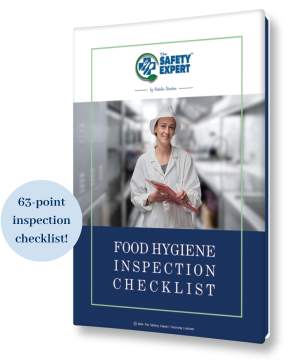
FREE CHECKLIST!
- Be prepared for your Food Hygiene Inspection
- Feel confident about achieving a Top Food Hygiene Rating for your business
- Created by Chartered Environmental Health Officer, Natalie Stanton
- Covers the 3 areas an officer will assess during your inspection
Here's how I can help you
Get food safety training from an Environmental Health Officer (EHO).
This is the UK’s first self-taught, online Level 2 Food Safety & Hygiene course for Catering that is created and taught by EHO, Natalie Stanton. There are no PowerPoint slides and no monotonous voiceover. In only 2 hours, Natalie guides you through the key aspects of food safety in 13 short, pre-recorded videos.

